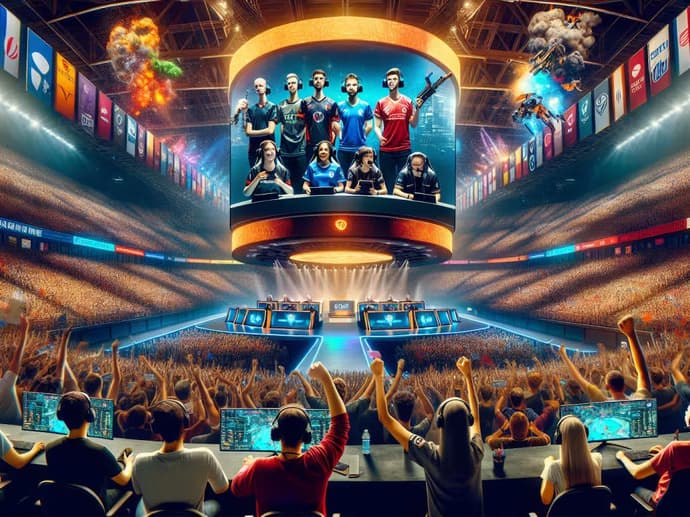
eSports: How Competitive Gaming Became a Global Phenomenon

In the last decade, eSports has transformed from niche online communities into a mainstream global sensation. What was once a hobby for gamers has become a multi-billion-dollar industry, complete with professional leagues, massive sponsorships, and millions of dedicated fans. With games like "League of Legends," "Dota 2," and "Fortnite" drawing massive viewership numbers, eSports has firmly established itself as a cornerstone of modern entertainment. But how did this competitive gaming revolution happen, and where is it headed next?
The Rise of eSports: From Local Tournaments to Global Stages
The roots of competitive gaming can be traced back to the early 2000s, with local tournaments and LAN parties attracting passionate gamers. However, the rise of faster internet speeds and streaming platforms like YouTube and Twitch in the 2010s allowed competitive gaming to explode on a global scale. Suddenly, fans could watch their favorite players and teams from anywhere in the world, live and in real-time.
What truly set eSports apart was its ability to build massive communities around specific games. Titles like "Starcraft" in South Korea were some of the first to elevate gaming to a professional level, with organized leagues and televised matches. From there, eSports gained traction in Europe and North America, eventually evolving into an international spectacle with major tournaments, like "The International" for "Dota 2," offering prize pools in the tens of millions of dollars.
Today, eSports events can fill entire arenas, attracting fans much like traditional sports. Whether it’s the annual "League of Legends World Championship" or the electrifying "Call of Duty League," eSports tournaments now rival some of the biggest sporting events in terms of viewership and sponsorship.
The Professionalization of eSports
One of the key reasons for eSports' rapid rise is its professionalization. Unlike the casual gaming tournaments of the early days, today’s eSports teams are well-funded, with corporate sponsors, trainers, and analysts. Players, who are often scouted at a young age, are treated like athletes, undergoing rigorous training regimens and competing for contracts that can reach six or even seven figures.
eSports organizations, such as Cloud9, Team Liquid, and Fnatic, operate much like traditional sports franchises, managing teams across multiple games and securing lucrative deals with sponsors. In fact, major brands like Nike, Red Bull, and even car manufacturers have jumped on board, recognizing the value of reaching eSports’ young, tech-savvy audience.
The professional structure around eSports has helped transform it from a casual pastime into a full-fledged career for many talented players. Today, being a professional gamer is a dream job for millions of young fans around the world, who see their favorite eSports athletes as role models.
The Role of Streaming Platforms
Streaming platforms like Twitch, YouTube, and Facebook Gaming have played an essential role in the rise of eSports. These platforms allow fans to watch live competitions, interact with their favorite players through chat, and engage with gaming content 24/7. The interactive nature of streaming helps build strong communities around specific games and players, creating an unparalleled sense of engagement.
Twitch, in particular, has become synonymous with gaming culture. With millions of daily active users, it provides a space where fans can follow their favorite eSports players, learn new strategies, and watch live tournaments. Streaming has turned gaming into a social experience, making eSports more accessible and inclusive to a global audience.
Monetization and the Business of eSports
The financial success of eSports has caught the attention of investors, brands, and media companies alike. Revenue in eSports comes from various sources, including sponsorships, advertising, media rights, ticket sales for live events, and in-game purchases. Companies like Coca-Cola, Intel, and even luxury brands have sponsored teams and events, reflecting the growing mainstream appeal of eSports.
Media rights deals, in particular, have boosted the industry’s financial potential. Just as traditional sports sell broadcasting rights to networks, eSports tournaments and leagues now negotiate streaming and broadcasting deals, bringing in significant revenue. This has helped transform eSports from an underground subculture into a global entertainment powerhouse.
In addition to traditional monetization methods, some players in the eSports world are venturing into new areas like cryptocurrency and blockchain. For example, gaming platforms are increasingly adopting cryptocurrency payments for in-game purchases or prize pools. Similarly, casino games like crypto blackjack are offering gamers and bettors a chance to engage with their favorite pastimes using digital currencies. These developments signal a future where eSports and crypto could intersect even further, driving innovation in how games are played, funded, and monetized.
The Future of eSports
As eSports continues to grow, its future looks brighter than ever. With an ever-expanding fan base and continued investments from major corporations and media outlets, eSports is likely to keep evolving. The introduction of 5G technology and advancements in virtual reality (VR) and augmented reality (AR) will only enhance the viewing experience, allowing fans to immerse themselves in competitions like never before.
Moreover, the inclusion of eSports in events like the Asian Games and the potential for future Olympic recognition shows just how far competitive gaming has come. The recognition of eSports as a legitimate sport further validates its place in the global entertainment landscape.
However, challenges remain. The mental and physical toll on players, many of whom face burnout at a young age, is a growing concern. In response, teams are now focusing on players’ health and well-being, with many employing mental health professionals and fitness trainers to ensure longevity in their careers.
Conclusion: The Global eSports Revolution
From small LAN tournaments to sold-out arenas and multimillion-dollar prize pools, eSports has grown into a global phenomenon that shows no signs of slowing down. The combination of professionalization, streaming platforms, and mainstream interest has catapulted competitive gaming into the spotlight. As technology continues to evolve and new opportunities emerge, eSports is poised to redefine entertainment for years to come.
With its unique blend of skill, strategy, and community, eSports has captured the hearts of millions, making it one of the most exciting developments in modern entertainment. Whether you’re a gamer, a fan, or just curious about this digital revolution, there’s no denying that eSports is here to stay.

Elen Stelmakh est une personne créative qui se consacre à l'avancement de la culture des jeux vidéo par le biais d'articles et de conceptions visuelles. En tant qu'auteur d'EGamersWorld et concepteur d'un site Web de jeux à temps plein, Elen ne se contente pas de créer du contenu, elle y insuffle également de l'énergie et de la créativité.
 Quoi de neuf dans Winter Offensive : Battlefield 6 Mise à jour 1.1.3.0Winter Offensive 1.1.3.0 apporte une carte enneigée, une nouvelle arme et un gameplay amélioré à Battlefield 6.
Quoi de neuf dans Winter Offensive : Battlefield 6 Mise à jour 1.1.3.0Winter Offensive 1.1.3.0 apporte une carte enneigée, une nouvelle arme et un gameplay amélioré à Battlefield 6. Date et heure des Game Awards 2025 dans le monde entierLa date et l'heure de TGA 2025 ont été confirmées pour un spectacle mondial en direct diffusé sur les principales plateformes.
Date et heure des Game Awards 2025 dans le monde entierLa date et l'heure de TGA 2025 ont été confirmées pour un spectacle mondial en direct diffusé sur les principales plateformes. StarLadder Budapest Major 2025 - Playoff Pick'em : Prédictions et opinionsStarLadder Budapest Major 2025 Playoff Pick'Em guide : pronostics de bracket, opinions d'experts et conseils clés pour vous aider à gagner la pièce de diamant tant convoitée.
StarLadder Budapest Major 2025 - Playoff Pick'em : Prédictions et opinionsStarLadder Budapest Major 2025 Playoff Pick'Em guide : pronostics de bracket, opinions d'experts et conseils clés pour vous aider à gagner la pièce de diamant tant convoitée. Voler un Brainrot Événement de l'heure d'hiver Brainrots de Noël et comment les obtenirDécouvrez tous les Brainrots de Noël de l'événement Voler un Brainrot de l'heure d'hiver et comment les obtenir.
Voler un Brainrot Événement de l'heure d'hiver Brainrots de Noël et comment les obtenirDécouvrez tous les Brainrots de Noël de l'événement Voler un Brainrot de l'heure d'hiver et comment les obtenir.


